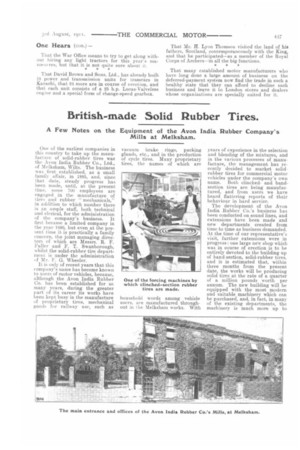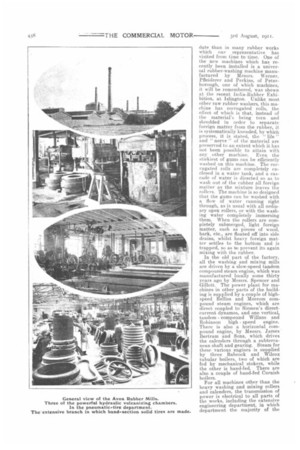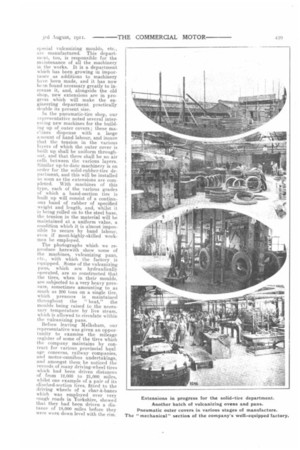British-made Solid Rubber Tires.
Page 3

Page 4

Page 5

If you've noticed an error in this article please click here to report it so we can fix it.
A Few Notes on the Equipment of the Avon India Rubber Company's Mills at Melksham.
One of the earliest companies in this country to take up the manufacture of solid-rubber tires was the Avon India Rubber Co., Ltd., of Melksham, Wilts. The business was first established, as a small family affair, in 1885, and, since that date, steady progress has been made, until, at the present time, sonic 700 employees are engaged in the manufacture of tires and rubber " mechanicals," in addition to which number there is an ample staff, both technical and clerical, for the administration of the company's business. It first became a limited company in the year 1890, but even at the present lime it is practically a family concern, the joint managing directors of which are Messrs. R. F. Fuller and F. T. Swanborough, whilst the solid-rubber tire department is under the administration of Mr. F. G. Wheeler.
It is only of recent years that this company's name has become known to users of motor vehicles, because, although the Avon India Rubber Co. has been established for so many years, during the greater part of its career its works have been kept busy in the manufacture of proprietary tires, mechanical goods for railway use, such as vacuum brake rings, packing glands, etc., and in the production of cycle tires. Many proprietary tires, the names of which are
household words among vehicle users, are manufactured throughout. in the Melksham works. With years of experience in the selection and blending of the mixtures, and in the various processes of manufacture, the management has recently decided to market solidrubber tires for commercial motor vehicles under the company's own name. Both clinchedand bandsection tires are being manufactured, and from users we have heard flattering reports of their behaviour in hard service.
The development of the Avon India Rubber Co.'s business has been conducted on sound lines, and extensions have been made and new departments created from time to time as business demanded. At the time of our representative's visit, further extensions were in progress : one large new shop which was in course of erection is to be entirely devoted to the building up of band-section, solid-rubber tires, and it. is estimated that, within three months from the present date, the works will be producing solid tires at the rate of a quarter of a million pounds worth per annum. The new building will be equipped with the most modern and suitable machinery which can be purchased, and, in fact., in many of the existing departments, the machinery is much more up to
date than in many rubber works which our representative has visited from time to time One of the new machines -which has recently been installed is a universal rubber-washing machine manufactured by Messrs. Werner, Pfleiderer and Perkins, of Peterborough, one of which machines, it will be remembered, was shown at the recent India-Rubber Exhibition, at Islington. Unlike most other raw rubber washers, this machine has corrugated rolls, the effect of which is that, instead of the material's being torn aml shredded in order to separate foreign matter from the rubber, it is systematically kneaded, by which process, it is stated, the "life " and " nerve " of the material are preserved to an extent which it has not been possible to attain with any other machine. Even the stickiest of gums can be efficiently washed on this machine. The corrugated rolls are completely enclosed in a water tank, and a cascade of water is directed so as to wash out of the rubber all foreign matter as the mixture leaves the rollers. The machine is so designed that the gums can be washed with a flow of water running right through, as is usual with all ordinary open rollers, or with the washing water completely immersing them. When the rollers are completely submerged, light foreign matter, such as pieces of wood, bark, etc., are floated off into side drains, whilst heavy foreign matter Hettles to the bottom and is trapped, so as no prevent its again mixing with the rubber.
In the old part of the factory, all the washing and mixing mills are driven by a slow-speed tandem compound steam engine, which was manufactured locally some thirty years ago by Messrs. Spencer and Gillett. The power plant for machines in other parts of the building is supplied by a couple of highspeed Belliss and Morcom compound steam engines, which are direct coupled to Siemen's directcurrent dynamos, and one vertical, tandem compound Willans and Robinson high speed engine. There is also a horizontal compound engine, by Messrs. James Bertram and Sons, which drives the calenders through a subterranean shaft and gearing. Steam for these various engines is supplied by three Babcock and Wilcox tubular boilers, two of which are fed by mechanical stokers, while the other is hand-fedThere are also a couple of hand-fed Cornish boilers.
For all machines other than the heavy washing and mixing rollers and calenders, the transmission of power is electrical to all parts of the works, including the extensive engineering department, in which department the majority of the
special vulcanizing moulds, etc., are manufactured. This depart ment, too, is responsible for the maintenance of all the machinery in the works. It is a, department which has been growing in impor tance as additions to . machinery have been made, and it has now been found necessary greatly to in crease it., and, alongside the old shop, new extensions are in pro gress which will make the engineering department practically double its present size. In the pneumatic-tire shop, our ellrementative noted several interest ing new machines for the build ing up of outer covers ; these ma c'iines dispense with a large amount of hand labour, and insure that the tension in the various layers of which the outer cover is built up shall be uniform through out, and that there shall be no air cells between the various layers. Similar up-to-date machinery is on order for the solid-rubber-tire de partment., and this will be installed as soon as the extensions are com pleted. With machines of this type, each of the various grades of which a band-section tire is built up will consist of a continuous band of rubber of specified weight and length, and, whilst it is being rolled on to the steel base, the tension in the material will be maintained at a uniform value, a condition which it is almost impossible to secure by hand labour, even if most-highly-skilled workmen he employed.
The photographs which we reproduce herewith show some of the machines, vulcanizing pans, etc., with which the factory is equipped. Some of the vulcanizing pans, which are hydraulically operated, are so constructed that the tires, when in their moulds, are subjected to a very heavy pressure, sometimes amounting to as much as 200 tons on a single tire, which pressure is maintained throughout the "heat," the moulds being raised to the necessary temperature by live steam, which is allowed to circulate within the vulcanizing pans. Before leaving Melksham, our representative was given an opportunity to examine the mileage register of some of the tires which the company maintains by contract for various provincial haulage concerns, railway companies, and motor-omnibus undertakings, and amongst them he noticed the records of many driving-wheel tires which had been driven distances of from 12,000 to 21,000 miles, whilst one example of a pair of its clinched-section tires, fitted to the driving wheels of a char-i-bancs which was employed over very rough roads in 'Yorkshire, showed that they had been driven a distance of 18,000 miles before they were worn down level with the rim.






















